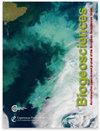CMIP6地球系统模式中的碱度偏差及人工增强碱度对模拟CO2减少的影响
IF 3.9
2区 地球科学
Q1 ECOLOGY
引用次数: 4
摘要
摘要大气和海洋之间CO2的分配在很大程度上不仅取决于溶解的无机碳(DIC)的数量,还取决于海洋表面的碱度。这也是为什么海洋碱度增强(OAE)作为负排放技术背景下的一种潜在方法进行讨论的原因。虽然碱度因此是海相碳酸盐体系的一个重要变量,但对其在模型中的表示与测量结果的比较知之甚少。基于GLODAPv2观测数据,对14个CMIP6地球系统模式(esm)的大尺度碱度分布进行了评估,结果表明,大多数模式和多模式平均值均低估了表层和上层海洋的碱度,而高估了深层海洋的碱度。将全球平均碱度偏差分解为以下因素的贡献:(i)物理过程(预形成的碱度),其中包括源自软组织和碳酸盐泵的偏碱度的物理再分配;(2)补充矿质;碳酸盐岩的形成和溶蚀作用表明,碱度的物理再分配造成的偏倚占主导地位。然而,在海拔几百米以下,碳酸盐溶蚀造成的偏压与物理偏压具有相似的重要性,而再矿化作用的贡献可以忽略不计。这突出表明,迫切需要更好地理解和量化驱动饱和层以上微环境中碳酸钙溶解的过程,并将这些过程应用到生物地球化学模型中。为了应用这些模型来评估OAE增加海洋碳吸收的潜力,我们使用每个模型的全球平均表面碱度、DIC和海水中CO2分压(pCO2)作为输入参数进行了粗略计算。我们评估了以下两个指标:(1)加入碱度后海洋表面co2的初始pCO2减少量;(2)达到海气平衡后的吸收效率(ηCO2)。表面碱度与DIC的相对偏差影响了Revelle因子,从而影响了加入碱度后的初始pCO2还原。在不同的模型中,相对于GLODAPv2的全球平均表面碱度偏差范围从−85 mmol m−3(−3.6%)到+50 mmol m−3(+ 2.1%)(平均值:−25 mmol m−3或−1.1%)。DIC的相对偏倚范围为−55 mmol m−3(−2.6%)至53 mmol m−3(+ 2.5%)(平均值:−13 mmol m−3或−0.6%)。除两个模型外,本文评估的CMIP6模型都将地表的Revelle因子高估了3.4%,从而将加入碱度后的初始二氧化碳分压减少高估了13%。吸收效率ηCO2考虑到较高的Revelle因子和碱度添加和平衡后较高的初始pCO2还原在很大程度上相互补偿,这意味着模型中产生的DIC差异很小(- 0.1%至1.1%)。在使用CMIP6模式报告海洋碱度增强实验的效率时,必须考虑到初始二氧化碳分压减少的高估,特别是在二氧化碳未达到平衡的情况下。本文章由计算机程序翻译,如有差异,请以英文原文为准。
Alkalinity biases in CMIP6 Earth system models and implications for simulated CO2 drawdown via artificial alkalinity enhancement
Abstract. The partitioning of CO2 between atmosphere and ocean depends to a large degree not only on the amount of dissolved inorganic carbon (DIC) but also on alkalinity in the surface ocean. That is also why ocean alkalinity enhancement (OAE) is discussed as one potential approach in the context of negative emission technologies. Although alkalinity is thus an important variable of the marine carbonate system, little knowledge exists on how its representation in models compares with measurements. We evaluated the large-scale alkalinity distribution in 14 CMIP6 Earth system models (ESMs) against the observational data set GLODAPv2 and show that most models, as well as the multi-model mean, underestimate alkalinity at the surface and in the upper ocean and overestimate it in the deeper ocean. The decomposition of the global mean alkalinity biases into contributions from (i) physical processes (preformed alkalinity), which include the physical redistribution of biased alkalinity originating from the soft tissue and carbonates pumps; (ii) remineralization; and (iii) carbonate formation and dissolution showed that the bias stemming from the physical redistribution of alkalinity is dominant. However, below the upper few hundred meters the bias from carbonate dissolution can gain similar importance to physical biases, while the contribution from remineralization processes is negligible. This highlights the critical need for better understanding and quantification of processes driving calcium carbonate dissolution in microenvironments above the saturation horizons and implementation of these processes into biogeochemical models. For the application of the models to assess the potential of OAE to increase ocean carbon uptake, a back-of-the-envelope calculation was conducted with each model's global mean surface alkalinity, DIC, and partial pressure of CO2 in seawater (pCO2) as input parameters. We evaluate the following two metrics: (1) the initial pCO2 reduction at the surface ocean after alkalinity addition and (2) the uptake efficiency (ηCO2) after air–sea equilibration is reached. The relative biases of alkalinity versus DIC at the surface affect the Revelle factor and therefore the initial pCO2 reduction after alkalinity addition. The global mean surface alkalinity bias relative to GLODAPv2 in the different models ranges from −85 mmol m−3 (−3.6 %) to +50 mmol m−3 (+2.1 %) (mean: −25 mmol m−3 or −1.1 %). For DIC the relative bias ranges from −55 mmol m−3 (−2.6 %) to 53 mmol m−3 (+2.5 %) (mean: −13 mmol m−3 or −0.6 %). All but two of the CMIP6 models evaluated here overestimate the Revelle factor at the surface by up to 3.4 % and thus overestimate the initial pCO2 reduction after alkalinity addition by up to 13 %. The uptake efficiency, ηCO2, then takes into account that a higher Revelle factor and a higher initial pCO2 reduction after alkalinity addition and equilibration mostly compensate for each other, meaning that resulting DIC differences in the models are small (−0.1 % to 1.1 %). The overestimation of the initial pCO2 reduction has to be taken into account when reporting on efficiencies of ocean alkalinity enhancement experiments using CMIP6 models, especially as long as the CO2 equilibrium is not reached.
求助全文
通过发布文献求助,成功后即可免费获取论文全文。
去求助
来源期刊

Biogeosciences
环境科学-地球科学综合
CiteScore
8.60
自引率
8.20%
发文量
258
审稿时长
4.2 months
期刊介绍:
Biogeosciences (BG) is an international scientific journal dedicated to the publication and discussion of research articles, short communications and review papers on all aspects of the interactions between the biological, chemical and physical processes in terrestrial or extraterrestrial life with the geosphere, hydrosphere and atmosphere. The objective of the journal is to cut across the boundaries of established sciences and achieve an interdisciplinary view of these interactions. Experimental, conceptual and modelling approaches are welcome.
 求助内容:
求助内容: 应助结果提醒方式:
应助结果提醒方式:


